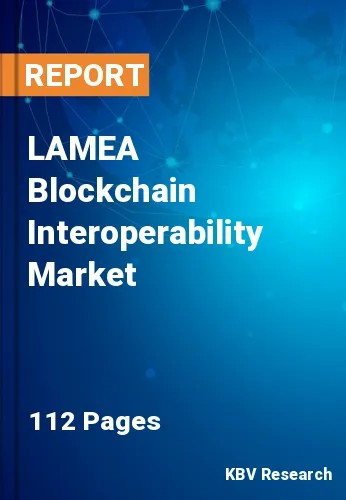The Latin America, Middle East and Africa Blockchain Interoperability Market would witness market growth of 35.3% CAGR during the forecast period (2023-2030).
Interoperability between blockchains enables the transmission of data and value between networks. It has evolved into an increasingly vital Web3 feature. The market is anticipated to offer opportunities worth billions of dollars to solution and service providers. Recession would have a significant impact on the market. Recession is anticipated to have conflicting effects on the blockchain interoperability market. A recession could result in decreased investments and budget cuts for technology-related initiatives, which could potentially delay the widespread adoption and roll out of blockchain interoperability solutions. Companies may prioritize cost-reduction measures over technological innovation. Furthermore, authorities and regulatory bodies might keep investing in blockchain technology in order to promote economic recovery, which may have a positive effect on the market.
As organizations strive to establish partnerships and construct interlinked networks, communication and data exchange between blockchains become essential. The growing interconnectedness of the Internet of Things enhances the demand, as it enables the secure and efficient communication of IoT devices through various blockchain networks. Increased collaboration and ecosystem expansion also contribute to the demand.
As part of its active involvement in providing credit facilities, the Saudi Arabian Monetary Authority (SAMA), the Kingdom's central bank, disclosed in June 2020 that it had utilized blockchain technology to discharge a portion of the SR50 billion ($13.3 bn) liquidity package into the banking sector. SAMA continues to investigate and implement emergent technologies in order to remain in sync with the global trends observed by other central banks. In addition, SAMA will be able to evaluate the effects of these technologies on the finance industry. The Saudi central bank is one of the first regional central banks to work with blockchain technology for money transactions. The Fintech Saudi Initiative in collaboration with the Capital Market Authority (CMA), the introduction of the SAMA Regulatory Sandbox, and a variety of digital banking services and payments are additional initiatives launched by SAMA to develop Fintech in the Kingdom.
The Brazil market dominated the LAMEA Blockchain Interoperability Market by Country in 2022, and would continue to be a dominant market till 2030; thereby, achieving a market value of $42.9 million by 2030. The Argentina market is showcasing a CAGR of 36% during (2023 - 2030). Additionally, The UAE market would register a CAGR of 34.9% during (2023 - 2030).
Based on Solution, the market is segmented into Cross-chain Bridging, Cross-chain APIs, Federated or Consortium Interoperability, and Others. Based on Application, the market is segmented into dApps, Digital Assets/NFTs, Cross-chain Trading & Exchange, and Cross-chain Messaging & Data Sharing. Based on Vertical, the market is segmented into BFSI, Healthcare, Gaming & Entertainment, Telecommunication, Food & Agriculture, IT & ITeS, and Others. Based on countries, the market is segmented into Brazil, Argentina, UAE, Saudi Arabia, South Africa, Nigeria, and Rest of LAMEA.
Free Valuable Insights: The Worldwide Blockchain Interoperability Market is Projected to reach USD 2.3 Billion by 2030, at a CAGR of 28%
The market research report covers the analysis of key stake holders of the market. Key companies profiled in the report include Oracle Corporation, R3, LeewayHertz, Ontology, INERY PTE. LTD., Datachain, Inc., Quant Network Limited, Band protocol, LiquidApps and Orb Labs.
By Solution
By Application
By Vertical
By Country
Our team of dedicated experts can provide you with attractive expansion opportunities for your business.

